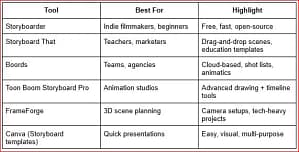In today’s visually-driven world, storyboard software has become an essential tool for creatives across industries — from filmmakers and animators to marketers, UX designers, and educators. A well-chosen storyboard platform can streamline your planning process, enhance collaboration, and bring your vision to life long before the first frame is shot or drawn.
But with so many options available, how do you choose the right storyboard software for your specific needs? This guide will walk you through the critical factors to consider and help you make a smart, long-term choice for your next project.
What is Storyboard Software?
Storyboard software allows users to visually plan scenes, shots, or sequences using a series of illustrated panels. It simulates a comic strip version of your project — complete with visuals, notes, dialogue, camera directions, and timing.
While traditional storyboarding involves paper and pencil, digital storyboard tools make the process more dynamic with drag-and-drop interfaces, animation previews, cloud-based collaboration, and easy export features.
Why the Right Software Matters
The right storyboard software can help you:
- Visualize complex ideas clearly
- Work efficiently with teams
- Reduce production errors
- Stay organized and on-schedule
- Communicate better with clients or stakeholders
The wrong tool, on the other hand, can slow you down with limitations, poor compatibility, or unnecessary complexity.
1. Define Your Project Goals
Before comparing features, ask yourself:
- What kind of project am I working on? (Film, animation, ad campaign, UX flow, eLearning module, etc.)
- Do I need detailed motion previews or just static frames?
- Will I work solo or with a team?
- Do I need the software to integrate with other tools (e.g., Final Cut, Adobe, Figma)?
- What’s my budget?
Your answers will shape which type of storyboard software will serve you best.
2. Consider Key Features
Every storyboard tool offers its own mix of features. Focus on those that align with your workflow:
a) Ease of Use
Look for intuitive drag-and-drop interfaces, pre-built templates, and simple navigation. If the tool has a steep learning curve, it might not be practical unless you’re working on a large-scale production.
b) Drawing Tools & Visual Assets
Depending on your artistic skills, you may need:
- Built-in sketching tools
- Image upload capability
- Asset libraries (props, characters, locations)
- Integration with Wacom tablets or iPads
Some software like Storyboard That is template-driven, while others like Storyboard Pro are tailored for hand-drawn professionals.
c) Collaboration & Sharing
If you’re working with a team or client, collaboration features matter:
- Real-time editing
- Cloud storage
- Commenting and feedback tools
- Version history
Cloud-based options like Boords or FrameForge offer strong collaboration tools.
d) Export Options
You’ll want the ability to export your boards in multiple formats:
- PDF (for presentations)
- MP4 (animated previews)
- CSV or shot lists (for production planning)
Make sure your chosen software fits the way you plan to present or deliver your storyboards.
e) Animation & Timing
If your project involves movement, such as in animation or video production, look for:
- Timeline and keyframe tools
- Camera angle previews
- Sound sync options
Storyboard Pro and Toon Boom are ideal for this level of detail.
3. Check Platform Compatibility
Some storyboard software is desktop-based, while others are entirely cloud-based. Depending on your workflow:
- Mac/Windows Compatibility: Ensure it runs smoothly on your system.
- Mobile Access: Do you need to edit on the go with a tablet or smartphone?
- Offline Access: Can you work without internet connectivity?
Cloud tools like Canva and Boords offer high accessibility but require a stable internet connection, while Storyboarder and Toon Boom are downloadable apps.
4. Review Your Budget
Storyboard software is available at every price point.For one-time or small projects, free tools might suffice. But for professionals or studios, premium software may be worth the investment for speed, quality, and advanced features.
5. Read Reviews & Test Before You Commit
Before subscribing, do your homework:
- Watch YouTube demos
- Read user reviews on Capterra or G2
- Use free trials to test workflow compatibility
- Ask peers in your industry for recommendations
Most good software tools offer free versions or trial periods — take advantage of these to see how well they align with your needs.
6. Top Storyboard Software to Consider (2025 Picks)
Here are some popular options, depending on your project type:
7. Bonus Tips for First-Time Users
- Start simple: Don’t get bogged down by complex features if you’re new.
- Keep it clear: Focus on communicating the idea, not perfect drawings.
- Update regularly: Make your storyboard a living document.
- Label everything: Use consistent naming for scenes, panels, and notes.
Involve your team: Get early feedback to avoid rework later.
Conclusion
Choosing the right storyboard software is about matching features and workflow to your specific creative process. Whether you’re creating an animated short, planning a UX journey, or pitching an ad concept — the right tool will make your job faster, clearer, and more collaborative.
Start by identifying your needs, test a few options, and don’t be afraid to grow into more advanced tools as your projects expand. With the right storyboard software, your ideas can leap off the page and into reality with clarity and confidence.


